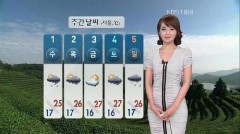Yo Kass answered
 The average amount of rainfall that the Korean peninsula sees in a year is approximately 60 inches.
The average amount of rainfall that the Korean peninsula sees in a year is approximately 60 inches.Korea is located in what is known as the 'temperate zone' and has four distinct seasons which all receive varying amounts of rainfall.
It's worth noting, however, that different regions will receive different amounts of rainfall depending on the terrain, distance from the coast etc...
Weather forecast for Korean seasons
The four seasons into which the Korean year is divided yield markedly-different amounts of rainfall. Because of its geographic location, Korea is considered to be a humid country and this causes a swing in meteorological conditions from one end of the year to the other.
- Spring: Expect light showers between March and May, with temperatures peaking at 71 degrees Fahrenheit, and lows of just 31. Rainfall sits at an average of 4 inches per moth.
- Summer: Average temperatures of between 70-80 degrees Fahrenheit. Rainfall increases considerably during the Summer and peaks in July, during monsoon season, with a whopping 15 inches of average rainfall. August showers usually drop down to 10 inches of rain.
- Fall: This is the shortest season and spans September to November. Although still relatively humid, the rain dries up considerably.
- Winter: The driest and coldest season of the year. Temperatures can drop to a chilly 23 degrees Fahrenheit, with the likelihood of snow and even more severe weather conditions in some parts of the country.
Travelling to Korea
If you're considering a trip to Korea, the best time of year to go is in either Spring or Fall. Summer months are often very wet - and the winter temperatures and heavy snowfall make visiting tourist attractions far less pleasant.